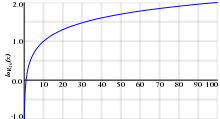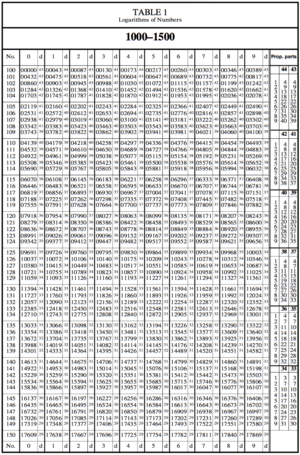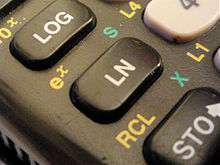Common logarithm

In mathematics, the common logarithm is the logarithm with base 10. It is also known as the decadic logarithm and also as the decimal logarithm, named after its base, or Briggsian logarithm, after Henry Briggs, an English mathematician who pioneered its use, as well as "standard logarithm". Historically, it was known as logarithmus decimalis[1] or logarithmus decadis.[2] It is indicated by log10(x), or sometimes Log(x) with a capital L (however, this notation is ambiguous since it can also mean the complex natural logarithmic multi-valued function). On calculators it is usually "log", but mathematicians usually mean natural logarithm (logarithm with base e ≈ 2.71828) rather than common logarithm when they write "log". To mitigate this ambiguity the ISO 80000 specification recommends that log10(x) should be written lg (x) and loge(x) should be ln (x).
Uses

Before the early 1970s, handheld electronic calculators were not available and mechanical calculators capable of multiplication were bulky, expensive and not widely available. Instead, tables of base-10 logarithms were used in science, engineering and navigation when calculations required greater accuracy than could be achieved with a slide rule. Use of logarithms avoided laborious and error prone paper and pencil multiplications and divisions. Because logarithms were so useful, tables of base-10 logarithms were given in appendices of many text books. Mathematical and navigation handbooks included tables of the logarithms of trigonometric functions as well.[3] See log table for the history of such tables.
An important property of base-10 logarithms which makes them so useful in calculation is that the logarithm of numbers greater than one which differ by a factor of a power of ten all have the same fractional part. The fractional part is known as the mantissa.[note 1] Thus log tables need only show the fractional part. Tables of common logarithms typically listed the mantissa, to 4 or 5 decimal places or more, of each number in a range, e.g. 1000 to 9999. Such a range would cover all possible values of the mantissa.
The integer part, called the characteristic, can be computed by simply counting how many places the decimal point must be moved so that it is just to the right of the first significant digit. For example, the logarithm of 120 is given by:
The last number (0.07918)—the fractional part or the mantissa of the common logarithm of 120—can be found in the table shown. The location of the decimal point in 120 tells us that the integer part of the common logarithm of 120, the characteristic, is 2.
Numbers greater than 0 and less than 1 have negative logarithms. For example,
To avoid the need for separate tables to convert positive and negative logarithms back to their original numbers, a bar notation is used:
The bar over the characteristic indicates that it is negative whilst the mantissa remains positive. When reading a number in bar notation out loud, the symbol is read as "bar n", so that is read as "bar 2 point 07918...".
The following example uses the bar notation to calculate 0.012 × 0.85 = 0.0102:
* This step makes the mantissa between 0 and 1, so that its antilog (10mantissa) can be looked up.
The following table shows how the same mantissa can be used for a range of numbers differing by powers of ten:
| number | logarithm | characteristic | mantissa | combined form |
|---|---|---|---|---|
| n (= 5 × 10i) | log10(n) | i (= floor(log10(n)) ) | log10(n) − characteristic | |
| 5 000 000 | 6.698 970... | 6 | 0.698 970... | 6.698 970... |
| 50 | 1.698 970... | 1 | 0.698 970... | 1.698 970... |
| 5 | 0.698 970... | 0 | 0.698 970... | 0.698 970... |
| 0.5 | −0.301 029... | −1 | 0.698 970... | 1.698 970... |
| 0.000 005 | −5.301 029... | −6 | 0.698 970... | 6.698 970... |
Note that the mantissa is common to all of the 5×10i. This holds for any positive real number because:
- .
Since is always an integer the mantissa comes from which is constant for given . This allows a table of logarithms to include only one entry for each mantissa. In the example of 5×10i, 0.698 970 (004 336 018 ...) will be listed once indexed by 5, or 0.5, or 500 etc..

History
Common logarithms are sometimes also called "Briggsian logarithms" after Henry Briggs, a 17th-century British mathematician. In 1616 and 1617 Briggs visited John Napier, the inventor of what are now called natural (base-e) logarithms at Edinburgh in order to suggest a change to Napier's logarithms. During these conferences the alteration proposed by Briggs was agreed upon; and after his return from his second visit, he published the first chiliad of his logarithms.
Because base 10 logarithms were most useful for computations, engineers generally simply wrote "log(x)" when they meant log10(x). Mathematicians, on the other hand, wrote "log(x)" when they meant loge(x) for the natural logarithm. Today, both notations are found. Since hand-held electronic calculators are designed by engineers rather than mathematicians, it became customary that they follow engineers' notation. So the notation, according to which one writes "ln(x)" when the natural logarithm is intended, may have been further popularized by the very invention that made the use of "common logarithms" far less common, electronic calculators.
Numeric value

The numerical value for logarithm to the base 10 can be calculated with the following identity.
as procedures exist for determining the numerical value for logarithm base e and logarithm base 2.
See also
Notes
- ↑ This use of the word mantissa stems from an older, non-numerical, meaning: a minor addition or supplement, e.g. to a text. Nowadays, the word mantissa is generally used to describe the fractional part of a floating point number on computers, though the recommended term is significand.
References
- ↑ Euler, Leonhard; Speiser, Andreas; du Pasquier, Louis Gustave; Brandt, Heinrich; Trost, Ernst (1945) [1748]. Speiser, Andreas, ed. Introductio in Analysin Infinitorum (Part 2). Opera Omnia, Opera Mathematica. 1 (in Latin). 9. B.G. Teubner.
- ↑ Scherffer, P. Carolo (1772). Institutionum Analyticarum Pars Secunda de Calculo Infinitesimali Liber Secundus de Calculo Integrali (in Latin). 2. Joannis Thomæ Nob. De Trattnern. p. 198.
- ↑ E. R. Hedrick, Logarithmic and Trigonometric Tables (Macmillan, New York, 1913).
- Abramowitz, Milton; Stegun, Irene A., eds. (1972), Handbook of Mathematical Functions with Formulas, Graphs, and Mathematical Tables, New York: Dover Publications, ISBN 978-0-486-61272-0
- Michael Möser: Engineering Acoustics: An Introduction to Noise Control. Springer 2009, ISBN 978-3-540-92722-8, p. 448 (restricted online copy, p. 448, at Google Books)
- A. D. Poliyanin, A. V. Manzhirov: Handbook of mathematics for engineers and scientists. CRC Press 2007, ISBN 978-1-58488-502-3, p. 9 (restricted online copy, p. 9, at Google Books)
External links
- "Briggsian logarithms". PlanetMath. includes a detailed example of using logarithm tables